Items filtered by date: October 2023
Common Foot Problems
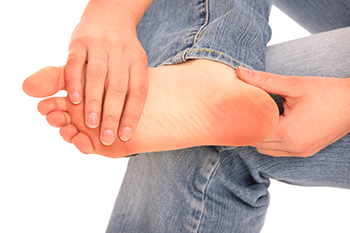
Because the feet undergo a great deal of activity and stress everyday, a number of problems may arise. Among the most common causes of foot pain are bunions, flat feet, ingrown toenails and plantar fasciitis. Bunions are deformities that develop at the base of the big toe, manifesting as a bump where two foot bones aren't connecting properly. Flat feet occur when the arch of the foot flattens due to a loss of elasticity in the main foot tendon. This condition can lead to chronic pain in the arch, ankle, and leg while walking. Hammertoes are characterized by a bending of the toe joint, causing the tip of the toe to angle sharply downward. The bent joint can jut upward and cause pain when it rubs against the top of your shoe. Ingrown toenails occur when the edge of the toenail grows into the skin, leading to redness, swelling, and intense pain. Plantar fasciitis is usually caused by tiny tears where the plantar fascia connects to the heel bone. While these common foot problems can be sources of discomfort, there are numerous strategies to manage and alleviate the associated pain. If you need guidance, it is suggested that you make an appointment with a chiropodist for an evaluation and treatment options.
Foot pain can have many causes. To receive an accurate diagnosis and treatment for your foot pain, please consult with Chiropodist Stephanie Poupore from North Bay Foot & Ankle. Our clinician will assess your condition and provide you with quality foot and ankle treatment.
Causes
There are a variety of different conditions that can cause foot pain, including:
Plantar fasciitis
Deformities, such as bunions or hammertoes
Injuries to the muscles, bones, tendons, or ligaments in the feet
Arthritis
Flat feet
Ingrown toenails
Symptoms
The type and location of your foot pain can help determine what may be causing it and what type of treatment options are best for you.
Common types of foot pain include:
Heel pain
Arch pain
Toe pain
Ball of foot pain
Pain that has a stabbing, burning, or tingling quality
Pain that is constant, intermittent, or that gets better or worse depending on the situation
Diagnosis
A thorough medical history and physical examination of your feet will be required to determine a diagnosis. Imaging studies, such as X-rays or MRIs may be performed to rule out or confirm certain diagnoses.
Treatment
Treatment will depend on the cause of the pain. Common treatments for foot pain include resting, icing, compressing, and elevating the affected foot, wearing orthotics, or taking anti-inflammatory medications.
If you have any questions, please feel free to contact our office located in . We offer the newest diagnostic and treatment technologies for all your foot care needs.
The Importance of Wearing Shoes That Fit
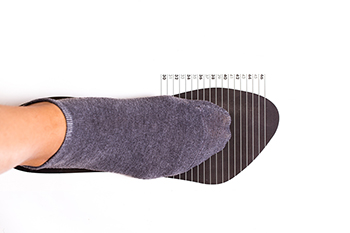
It has been reported that upwards of half of adults wear shoes that fit improperly, either in the arch and foot length or width. The wrong fit can cause significant foot pain and discomfort, not to mention a number of mild to serious foot conditions, even if you have comfortable shoes. When shopping for running shoes, athletic shoes, or men's and women's shoes, knowing your correct size will benefit you in getting the best support and comfort for your feet. It is also important to understand whether you have a narrow or wide foot in order to have a better fit. Most stores have foot measuring devices that help you determine the length and width. Be sure to select a shoe that is shaped like your foot, and avoid those that are too tight. If your feet are different sizes, it is better to fit the shoes to the larger size foot. Make sure there is a half an inch of space between the longest toe and the tip of the shoe while standing up. Walk in the shoes to make sure they fit and feel right, and most importantly, select by how it fits rather than by the size marked on the box. For help in finding the right shoe size, especially if you have chronic foot ailments, it is suggested that you make an appointment with a chiropodist.
Finding the right shoes can be a hassle, however, wearing properly fitted shoes is one of the best things that you can do to prevent future foot problems. For more information about the importance of wearing the right shoe size, please consult with Chiropodist Stephanie Poupore from North Bay Foot & Ankle. Our clinician can help you maintain the health of your lower limbs and your mobility.
Tips for finding shoes that fit
Measure your foot - This should be done later in the day when your feet are naturally at their largest. An associate at a shoe store can measure your foot using a Brannock device.
Wear the right socks - You should be wearing the socks or other hosiery that you intend to wear with the kind of shoe you are looking for. For example, if you are shopping for running shoes, wear the socks that you would normally wear while running.
Remember these numbers - When trying on shoes, there should be about ½ an inch of space between the end of your longest toe and the end of the front of the shoe, and ⅛ of an inch between the back of your heel and the shoe
Don’t “break them in” - Any shoes you buy should be immediately comfortable; don’t settle for shoes that you have to “break in" before you can wear them out.
A chiropodist can help you find the best shoes and orthotics to help maintain the health of your feet. If you have any questions, please feel free to contact our office located in . We offer the newest diagnostic and treatment technologies for all your foot care needs.
Effects of Cold Winter Weather on Feet
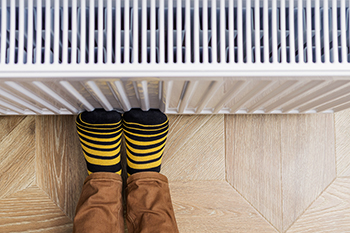
During the winter, feet can face various challenges. Cold temperatures can leave feet feeling chilly and numb, making them uncomfortable. The cold air of winter can also lead to dry and cracked skin on the feet, which not only hurts but can also increase the risk of infections. Chilblains, small, itchy swellings on the skin, may develop when feet are exposed to cold and then rapidly warmed, causing additional discomfort. In extreme cold, frostbite is a concern, potentially leading to tissue damage if feet are not adequately protected. Additionally, winter footwear, while designed for insulation, may lack proper arch support and can contribute to discomfort or pain. Icy sidewalks and roads increase the risk of slips and falls, which can result in foot injuries. Cold weather can constrict blood vessels, reducing blood flow to the extremities, and causing numbness and discomfort in the feet. To maintain comfortable and healthy feet during winter, it is important to wear warm, insulated footwear, keep your feet dry and moisturized, and exercise caution in slippery conditions. If you are experiencing specific foot concerns or conditions due to cold weather, it is suggested that you make an appointment with a chiropodist for a proper evaluation and treatment.
The winter months can bring about new or worsening foot and ankle problems. If you’re suffering from foot or ankle pain, please consult with Chiropodist Stephanie Poupore from North Bay Foot & Ankle. Our clinician can help you maintain the health of your lower limbs and your mobility.
Winter Foot Problems
Cracked heels - Dry, cracked skin on the heels of the feet that is associated with cold, dry weather
Athlete’s foot - A fungal infection on the skin of the feet
Blisters - Fluid-filled bubbles of skin that usually form in response to friction
Fractures - Broken bones in the feet or ankles
Metatarsalgia - General foot pain
Chilblains - Spasming of the small blood vessels in the toes in response to exposure to cold weather
Raynaud’s disease - Numbness, pain, and color changes in the toes due to cold weather
Prevention
Wear warm socks and shoes
Avoid prolonged exposure to the cold
Moisturize the heels regularly
Keep your feet clean and dry
Walk carefully in areas that may be icy
Wear non-slip shoes
If you have any questions, please feel free to contact our office located in . We offer the newest diagnostic and treatment technologies for all your foot care needs.
Do Your Child's Feet Hurt?
Vulnerable Bones That Can Fracture in the Foot
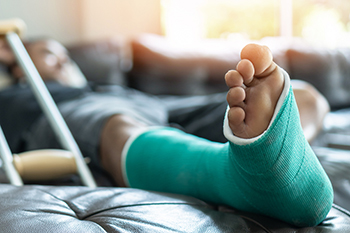
The human foot is an intricate structure composed of a network of bones, all susceptible to fractures under certain circumstances. Understanding which bones are most prone to fractures is essential for recognizing and addressing potential injuries. Long, slender bones, known as the metatarsal bones, make up the midfoot and are susceptible to fractures due to trauma or stress. A common example is a Jones fracture that occurs near the base of the fifth metatarsal. The heel bone, known as the calcaneus, can fracture from falls, high-impact injuries, or vehicle accidents. The tarsal bones in the hindfoot can fracture, with the navicular bone being a particularly vulnerable site. Additionally, the small sesamoid bones embedded in the tendons beneath the big toe can fracture due to repetitive stress. Identifying the specific bone involved and the nature of the fracture can help determine the proper diagnosis. If you have broken your foot, it is suggested that you seek the counsel of a chiropodist who can determine the best course of treatment for your specific type of fracture.
A foot fracture is a crack or break in a foot bone, often caused by repetitive stress on the foot or a high-impact foot injury. If you’re suffering from foot pain, please consult with Chiropodist Stephanie Poupore from North Bay Foot & Ankle. Our clinician can help you maintain the health of your lower limbs and your mobility.
Symptoms
Pain
Bruising
Tenderness
Swelling
Difficulty walking
Deformity
Causes
Repetitive overloading of the foot
Having a previous fracture
Abnormal foot biomechanics
Changing training surfaces suddenly
Poor footwear
Osteoporosis
High-impact injury
Treatments
Rest
Ice
Elevation
Pain medication
Braces or other orthotics
Casts
Crutches
Surgery in more severe cases
If you have any questions, please feel free to contact our office located in . We offer the newest diagnostic and treatment technologies for all your foot care needs.
Definition and Symptoms of Ankle Sprains
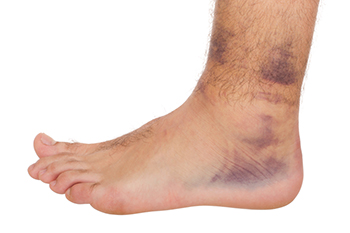
An ankle sprain is a common injury that occurs when the ligaments surrounding the ankle joint are stretched or torn. This injury typically happens when the foot twists or rolls beyond its normal range of motion, often during physical activities such as sports, walking on uneven surfaces, or even a simple misstep. Symptoms of an ankle sprain can vary in severity. Pain, swelling, and bruising around the affected ankle are the most noticeable signs. You may also experience difficulty bearing weight on the injured foot, and the joint may feel unstable or weak. In more severe cases, a popping sound may be heard at the time of injury, indicating a more significant ligament tear. It is essential to seek immediate medical attention if you suspect an ankle sprain, as untreated sprains can lead to chronic pain or instability. Early diagnosis and proper care, including rest, compression, and elevation may help to prevent long-term complications and ensure a swift recovery. Understanding the definition and symptoms of an ankle sprain is the first step toward effective management and a speedy return to normal activities. If you have endured an ankle sprain, it is suggested that you consult a chiropodist for a proper diagnosis and tailored treatment plan.
When one or more ligaments in the ankle overstretch or tear due to injury, an ankle sprain occurs. If you would like to learn more about ankle sprains, please consult with Chiropodist Stephanie Poupore from North Bay Foot & Ankle. Our clinician can help you maintain the health of your lower limbs and your mobility.
Symptoms of an ankle sprain vary depending on the severity of the injury, but may include:
Pain
Swelling
Bruising
Tenderness
Difficulty walking
Ankle instability
A reduced range of motion in the ankle
Treatments for an ankle sprain may consist of:
Resting the injured ankle
Applying ice
Elevating the ankle
Compressing the ankle
Over-the-counter pain medications
Ankle braces or other devices to take weight off of the ankle
Ankle exercises
Surgery (in rare cases)
It’s important for the sprained ankle to heal correctly and fully in order to avoid repeated injury. If you have any questions, please feel free to contact our office located in . We offer the newest diagnostic and treatment technologies for all your foot care needs.

